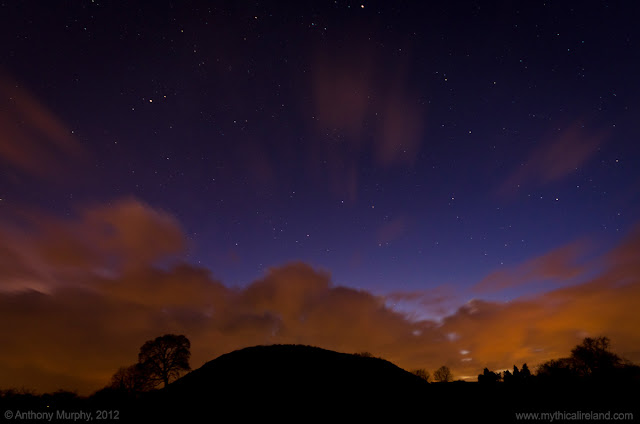Tuesday 20 November 2012
Newgrange then and now - pre and post excavation
Just some food for thought. These photos show Newgrange before, during and after the restoration/conservation work which took place during the archaeological excavation of the mound in the 1960s and 1970s. On top is a picture of the monument as it appeared before the archaeological work. The second picture shows the giant concrete wall which was added to the front of the mound. The main purposes of this wall are to prevent cairn slippage out over the kerbstones, which had happened previously in the Bronze Age, and to securely fasten the white quartz and granite cobble stones which form the modern facade. These stones were found to be on the ground, beneath the cairn slip material. The archaeologist deduced from experimentation that the quartz had to have been placed on the front of the mound in order to have ended up underneath the cairn slip material. Interestingly, some kerbstones had fallen over as a result of the cairn slippage. There was no quartz underneath the stones that had fallen over!
Saturday 17 November 2012
Moon and stars over Newgrange
 |
| A crisp winter sky over Newgrange, featuring the moon and the constellation Aquila, the Eagle. |
 |
| A similar scene except this one includes the cross- shaped Cygnus, as well as Lyra. |
 |
| A star-filled November sky over Newgrange. |
Thursday 15 November 2012
Stunning skies over Dowth this evening . . .
 |
| A stunning evening sky over the Neolithic passage-mound of Dowth this evening. |
I was hoping to get a photo from the top of Dowth looking at the sunset towards Newgrange. However, the sky was almost completely overcast when the sun went down. However, as night came in the clouds started to break up quite nicely, allowing the stars to shine through. I got busy finding a location where the sky would form a dramatic backdrop to the mound.
What I particularly love about this shot, and some of the others that I took, is that the clouds seem to mimic the profile of the mound and trees. The orange colour of the clouds is light pollution from the town of Navan, some 10 or 12 miles to the west. They gave a dramatic contrast to the deep blue of the sky's afterglow.
The shot below was taken five minutes later. The sky was darker, but the clouds were brighter! Light pollution is becoming a major problem in Ireland.
Following my Newgrange ancestors at Rathcor beach
This is a short video I made back in August while visiting Rathcor beach on the Cooley peninsula, said by geologists to have been the place where the builders of Newgrange sourced the granite cobble stones which are interspersed with white quartz on the front of the monument.
Rathcor is a most incredible beach. it is little visited by humans - precisely because all the stones there make it difficult to walk about, and dangerous for children. There is a sense of something untouched down there - something that has remained the same for five millennia.
Ironically, the granite at Cooley is not native. It originates further north, in the Mourne Mountains. How it got to the southern shore of the Cooley Peninsula is another question.
A journey to Rathcor, to see one of the sites from which the Newgrange builders got their stone, will send shivers up the spine and give you goosebumps. You can almost imagine meeting one of your ancestors there, picking up stones . . .
Monday 12 November 2012
Sunset over a hill called 'Réaltoge', meaning 'star'
This is the sun setting behind a hill called Réaltoge, meaning 'star, as viewed from the top of Dowth in December 2003. In the view also is Newgrange.
Sunday 11 November 2012
Newgrange - A Dream of Angus Og by George William Russell
This is a video I've made featuring words from George Russell's 'A Dream of Angus Oge' (1897) set to the backdrop of my photos of Newgrange and mystical music by Matthew Florianz.
Thursday 1 November 2012
Video: Newgrange book excerpt read by author Anthony Murphy
A much longer, 55-minute version of this video is available at this page on Mythical Ireland.
Subscribe to:
Posts (Atom)



